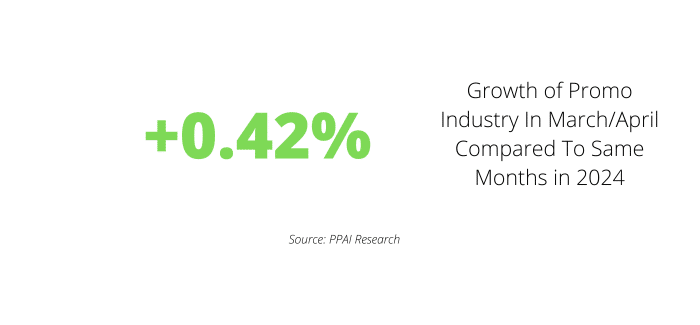The signs were there in 2025’s first bi-monthly survey on the state of the industry, when year-over-year growth dipped significantly below 1%, representing worse returns than any two-month stretch in 2024.
Now, PPAI Research’s most recent bi-monthly survey has confirmed a continuation of that trend. The good news is that the industry technically continues to grow, but the growth margins have only become thinner four months into the year.
- In March and April, industry revenue grew by 0.42% compared to the same two-month period in 2024.
- Worse yet, this number lags well behind the current inflation rate of 2.3, which many economists believe will rise this year.
- Following a trend noticed in January and February, growth was slowed much more noticeably for suppliers than distributors, suggesting that the former are seeing the brunt of supply chain challenges before such pains reach their distributor partners, at least for the time being.
According to Alok Bhat, market economist and PPAI’s research and public affairs lead, businesses are finding it increasingly difficult to offset rising input costs and maintain profitability. Those challenges are likely to remain, at least in the short term, and it will take delicate and strategic planning amid the external factors facing so many industries at the moment.

“As 2025 progresses, firms must sharpen their sourcing models, build fulfillment agility and advocate for trade policies that ease tariff pressure, stabilize pricing and enable sustainable growth,” Bhat says.
- The latest revenue data isn’t cultivated from the same methodology as the annual U.S. Distributor Sales Volume Estimate, which polls U.S. distributors of all sizes.
- Rather, the current assessment stems from the aggregated results of PPAI 100 distributors and suppliers responding to a flash survey.
As promo’s growth rate inches closer to zero, there will be eager eyes on the next bi-monthly survey results for May and June.
It should be noted that the months (March and April) for which this data represents concerns the initial months that President Donald Trump put sweeping tariffs in place, which, in the case of Chinese imports, peaked at 145% in early April (in addition to tariffs implemented during his first term).
RELATED: From Capitol Hill To Crisis: A Firsthand Look At Tariffs’ Impact On Small Business
In May, the U.S. and China negotiated to a 90-day lowering of tariffs to 30%. Additionally, Chinese imports under $800 in value, which were previously exempt under de minimis but had briefly been placed under tariffs at 120% of their value, have now had those tariffs lowered to 54%, providing possible relief to certain e-commerce and smaller companies who had been relying on the loophole. Such packages will also now have a $100 flat fee, instead of the $200 flat fee that was set to go into effect in June.
Unless a new deal is worked out in the meantime, the next bi-monthly report will cover months defined by these temporarily lowered China tariffs. This may provide relief from April’s tariff peak, but it’s unlikely to bring any much-desired certainty.
Supplier Results
In March and April (as was the case in January and February), it was reporting by suppliers that seemed to account for much of the industry’s slowed growth rate.
- Only about half (51%) of suppliers reported revenue growth in March and April.
- While that still represents a majority, only 7% reported what they considered significant gains.
For the 12% of suppliers that reported flat revenue, they seem to be occupying shaky ground in the current moment. Flat revenue could be seen as foreboding in an economy with an inflation rate of 2.3% and rising.
- A potentially worrying 37% of suppliers reported a decline in revenue. This is slightly more than were claiming down revenue in January and March and considerably more than in all of 2024.
The reasoning behind this pressure on suppliers seems to be based on a new reality: Costs keep climbing. Just under 80% of suppliers reported an increase in procurement costs.

Alok Bhat
Market Economist, Research & Public Affairs Lead, PPAI
“Cost increases are the norm, not the exception,” Bhat says. “Suppliers that haven’t yet felt the squeeze may only be a quarter or two behind.”
Distributor Results
The trend has continued through the first four months of 2025: The distributor results, taken in a vacuum, paint a rosier picture. Unlike suppliers, whose revenue increases stand at about 50/50, the survey finds that 81% of distributors report revenue growth.
- In fact, more than a third (35%) of distributors reported significant gains in revenue.
The numbers speak well of distributors’ handling of 2024, but if supplier struggles continue, it becomes difficult to imagine a scenario where such slowed growth doesn’t more significantly trickle down to distributors as well. In April, Denise Taschereau, CEO of Vancouver-based distributor Fairware and PPAI Board Chair, admitted that the industry faced potential difficulties with such low growth rates.

Denise Taschereau
PPAI Board Chair & CEO, Fairware
“While growth has slowed compared to the end of last year, it’s encouraging to see continued resilience across the industry, especially among distributors,” says Taschereau. “I’m expecting these small gains will be hard to maintain in the face of an all-out tariff war, but our industry has shown itself to be agile and value-driven in the past.”
___
The full report will be available to all Professional-tier members via Premium Research within two months.
Upgrade your PPAI membership here to receive access to the full report.


